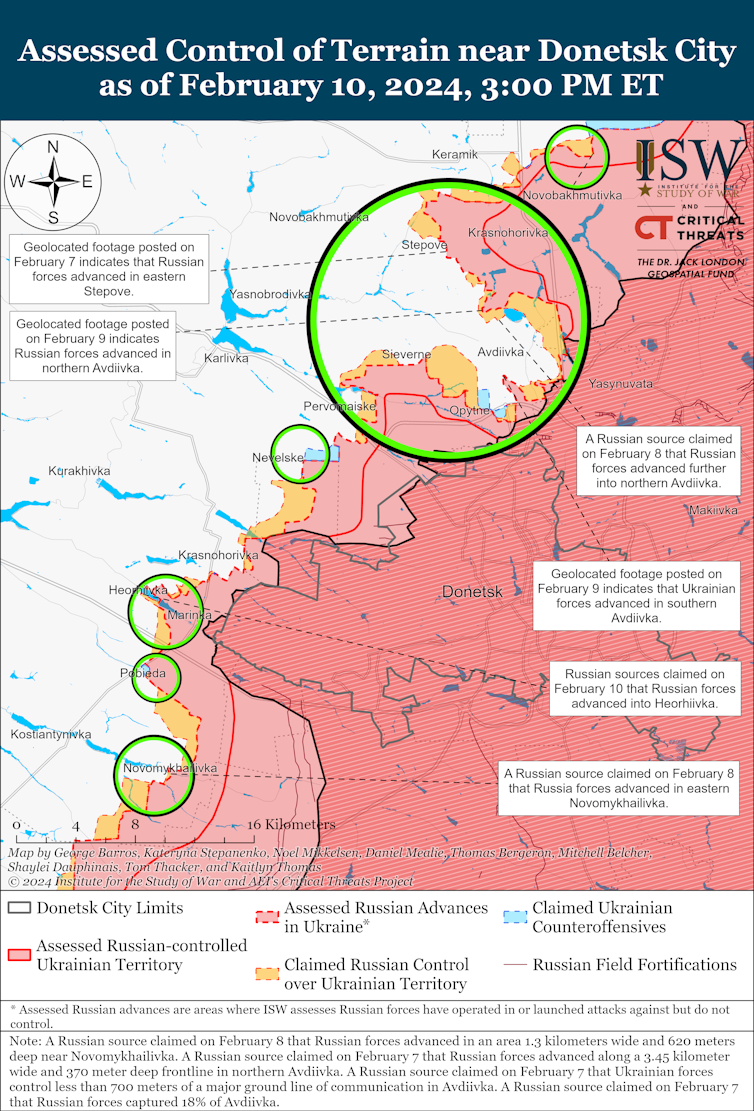The recent replacement of Valeriy Zaluzhnyi as commander-in-chief of Ukraine’s armed forces may have put a temporary end to the increasingly public disagreements between the very popular ‘iron general’ and the Ukrainian president, Volodymyr Zelenskyy. But it has not answered the fundamental question of what a winning—or even surviving—strategy in the war with Russia could look like as it moves into its third year.
Various dynamics have come together that are deeper and more complex than just a major reshuffle of the military leadership. The bigger picture that will shape the future of the war—and with it the future of Ukraine and the European and international security order—comprises four main factors. These need to be analysed together to understand the present and, most importantly, future predicaments of Ukraine and its western partners.
Failed counter-offensive
First, the failure of the Ukrainian counter-offensive in 2023 and the increasing pressure that Russia has put on Ukraine’s frontlines and hinterland put into serious question the ability of Kyiv to win. This is especially the case if victory for Ukraine means forcing Russia’s complete withdrawal from all territory occupied since 2014. The impending fall of Avdiivka, a town about 20 kilometres to the west of Donetsk in the east of Ukraine, suggests Kyiv has ultimately a weaker hand to play in a battle of attrition when confronted by a ruthless adversary with greater resources.

Much like the loss of Bakhmut last May or Soledar in January 2023, this constitutes a symbolic rather than strategic defeat for Ukraine. It also represents, at best, a pyrrhic victory for Russia—as in the case of Bakhmut.
But taken together, and seen in the context of the failed 2023 counter-offensive, these have not just been symbolic defeats. They have marked a real and extremely wasteful loss of financial resources, manpower and military equipment.
Zelenskyy’s dismissal of Zaluzhny puts the blame for last year’s disappointed hopes clearly on the latter. It also indicates, more worryingly, a failure to learn the lessons of these setbacks on the part of the Ukrainian president. The fact that the new commander-in-chief, Oleksandr Syrskyi, is associated with several of these costly defeats—notably Bakhmut—does not bode well for the necessary change in Ukrainian strategy.
To his credit, Syrskyi also masterminded the defence of Kyiv in the early days of the war in 2022 and the successful counter-offensive the following summer which saw Ukraine recapture significant territory, first around Kharkiv in the north and then Kherson in the south. Notably, these successes happened before Russia embarked on the first of several mobilisations and shifted its economy to a war footing.
Faltering support
The second key factor to keep in mind is that Ukraine’s battlefield successes in 2022 occurred at a time when western support for Ukraine was in full swing. Those days are long gone. This has been evident in the protracted battles in the United States Congress over sending more military aid to Ukraine. The comments by the former president—and 2024 Republican nominee-apparent—Donald Trump on his lack of commitment to the North Atlantic Treaty Organization should he be re-elected in November are equally worrisome.
Despite some detractors, the European Union remains committed to support for Ukraine. This became clear following the recent agreement on a new €50 billion funding package through to 2027. But this will barely cover Ukraine’s budget deficit, let alone make up for a potentially significant drop in US military aid. Combined with Ukraine’s shrinking domestic capabilities to mobilise further resources, the war will have to be fought in far more difficult conditions than in the first two years.
Meanwhile, Ukrainian society is increasingly suffering from war fatigue. Military setbacks, economic decline, deteriorating living conditions, corruption and the scale of the loss of lives, among troops and civilians alike, make sustaining the war effort at current levels more difficult as well—especially if the goal remains retaking all the land that Russia has occupied since 2014.
The amended law on mobilisation, intended to underpin this strategy, was adopted in the Ukrainian parliament on February 6th. Its provisions, including lowering the conscription age from 27 to 25 years, mandatory digital certificates and electronic conscription notifications, as well as stricter penalties for evading military service, are further evidence of the waning enthusiasm in Ukrainian society for the war effort. Together with yet another 90-day extension of martial law and several financial measures designed to tighten the government’s control over the economy, the more draconian provisions in the new mobilisation law heighten the sense of uncertainty over Ukraine’s political direction.
Legitimacy in question
Zelenskyy’s presidential term comes to an end in May and new parliamentary elections would normally be due in the autumn. While it is generally agreed that elections are close to impossible at present, both the president’s and the parliament’s legitimacy after the expiry of their constitutional terms will be open to question.
This will ultimately be an issue for the constitutional court to resolve. But it has not stopped political forces within Ukraine opposed to Zelenskyy and his Servant of the People political party piling pressure on the president to agree to a government of national unity.
Given the lack of popularity of this opposition, associated primarily with the former president, Petro Poroshenko—whom Zelenskyy defeated in a landslide election in 2019—this is hardly driven by popular demand. But it nonetheless signals further political turmoil at a time when Ukraine needs unity.
It is not clear whether Zelenskyy’s dismissal of Zaluzhny will strengthen or weaken any political opposition. In the short term, it is likely to benefit Zelenskyy, whose popularity still dwarfs that of Poroshenko. Yet because replacing Zaluzhny has not come with a signal that Ukraine’s war strategy will fundamentally change, this is a very risky move on the part of Zelenskyy.
Maintaining the current direction asks Ukrainians for yet more sacrifices. What Zelenskyy is offering in return depends on a range of at best highly uncertain returns which depend on many factors beyond the Ukrainian president’s control.
This article is republished from The Conversation under a Creative Commons licence


